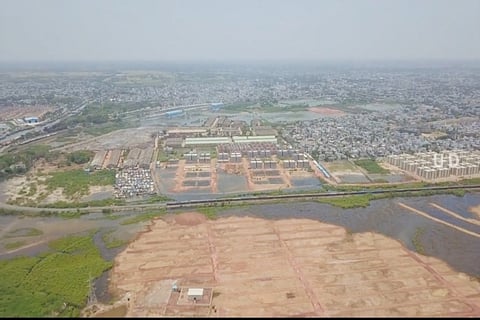

Over the past three months, coastal Andhra Pradesh has lost several acres of mangrove cover, near the fishing villages outside Kakinada town. An extension of East Godavari’s Mada (mangrove) forests, the land has been levelled by the state government authorities, for a housing scheme. Under ‘YSR Pedalandiriki Illu’ (housing for the poor), one of the flagship schemes of the YSRCP government, the government plans to use the land to build houses for beneficiaries of the scheme.
While the levelling work had begun around three months ago, the fishermen from nearby villages, who depended on the land for their livelihood, say that much of the work was carried out after the nationwide lockdown came into place from March 25. Since then, petitions have been filed with the National Green Tribunal (NGT) as well as the Andhra Pradesh High Court, objecting to the removal of the mangroves. While the High Court has ordered to maintain status quo on the construction activity, the NGT has constituted a five-member panel to look into the matter.
Meanwhile, opposition parties have become more vocal in their stand against the use of the coastal land for the scheme, and young people from the state have launched an online campaign called Save Mada Forests, to bring attention to the problem.
“It used to be completely green, full of saltwater creeks and mangrove trees,” says Chodipalli Sathish, who has moved the High Court on behalf of a group called Matsyakara Parirakshana Samithi (Fishermen’s Protection Committee), against the construction on the contested land.
More than 50,000 fisherfolk from nearly 18 fishing villages nearby were dependent on the wetlands for their livelihoods, Sathish says. Some portion of the land was used to dock the fishing boats. Different kinds of fish, shrimp and crab are also found in the saltwater creeks, which are also a source of livelihood, he explains.
Of the 120-acre mangrove land, nearly 100 acres have been levelled so far, with the mangroves being cut down and the salt creeks covered up with mud, according to Sathish.
“When they (the government) started the work about three months back, it was farther out from the sea. Since the lockdown began, much more work has been done, disrupting the area where people would fish or leave their boats,” he says.
While the fisherfolk are the ones who are immediately affected, the mangroves are a significant source of biodiversity, and form a protective cover from natural calamities like storms, as Nageswara Rao Kakani, who teaches at Andhra University’s Department of Geo-Engineering, points out.
“With conservation efforts from Andhra Pradesh Forest Department and other organisations, the mangrove cover in the area has actually improved since the ‘90s. This (its removal) would be a step backwards,” he says, adding that it will undo the gains from the ecological, economic and protective role of the mangroves.
He also warns that if the houses under the scheme eventually do come up on the land, the people living there will be at high risk in the event of heavy storm or floods.
The land where the construction activity was being carried out belongs to the Port Department of the state. Activists note that even if the land does not officially fall under the Mada forest land, as defined by the Forest Department, it is, however, an extension of the forest land, which is part of the Godavari mangroves.
District authorities, on the other hand, have denied that the housing project will result in any damage. East Godavari District Collector D Muralidhar Reddy claimed that the levelled land has not been notified as a mangrove forest and is not a protected area. He told The Hindu that the 115-acre site was around 10 kilometres away from the Coringa Wildlife Sanctuary, and is unrelated to the 86,000 acres of protected mangrove cover, which include the sanctuary.
“Forestation happens naturally when there is saline soil. The land is a few kilometres away from the Coringa wildlife sanctuary, but can be considered an extension of the Mada forest,” says Seshakumari, state co-convenor for INTACH (Indian National Trust for Art and Cultural Heritage). INTACH has also objected to the construction activity, saying the mangroves are a biodiversity heritage site.
But Sathish insists that owing to its proximity to the coastline, the land must be classified as a Coastal Regulation Zone (CRZ), and the issue must be addressed by the Centre. “We have been asking authorities for clarification on whether it can be considered as forest land or CRZ, but we received no proper response,” Sathish says.
The NGT petition by Bolisetty Satyanarayana, Jana Sena Party General Secretary and environmental activist, reportedly argued that the destruction of the mangrove land violates the Coastal Zone Regulation Notification, 2011 and 2019, the Environment Protection Act, 1986, the Biological Diversity Act and the Wildlife Protection Act.
On Tuesday, Leader of Opposition and Telugu Desam Party’s chief, Chandrababu Naidu tweeted about the issue. “Jagan Mohan Reddy’s decision to wipe out the Mada Forest will not just bring large-scale devastation to Kakinada in the form of storm surges and land erosion, but will also destroy the livelihoods of more than 54,000 fishermen and their families living in the region,” he wrote, with the hashtag ‘SaveMadaForestFromJagan’.
Soon, TDP leaders of East Godavari announced that they would visit the land to inspect the extent of the damage so far. But the fact-finding visit on Friday led to tension at the site, with the beneficiaries of the housing scheme objecting to the visit, The Hindu reported.
The NGT committee is expected to submit its report in three months.
While satellite images being shared on social media show a grim picture, Sathish says that the damage is not too severe. “If the final verdict is in favour of retaining the mangroves, the creeks can be restored to their former state eventually,” he says.
Chennai’s experience with the devastating floods in 2015 may have some lessons for Andhra on the dangers of constructions on wetlands and mangroves.